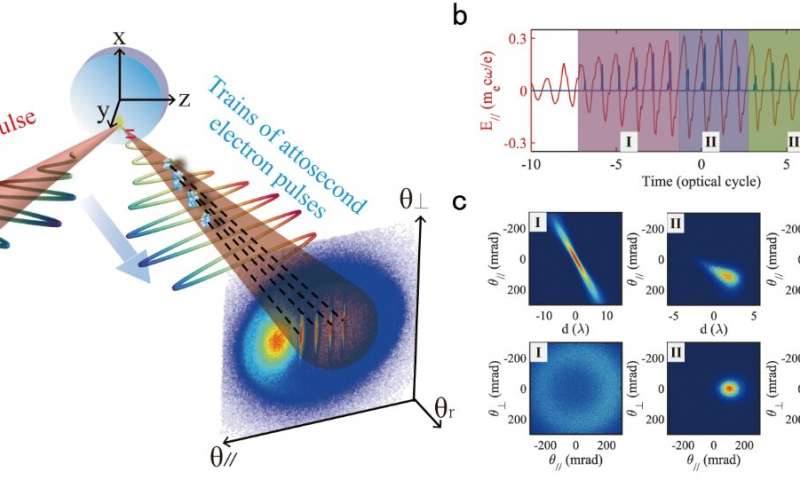
Recently, a research group from
the Shanghai Institute of Optics and Fine Mechanics of the Chinese Academy of
Sciences (CAS) has observed periodic electron bunch fringes induced by the
femtosecond laser field.
These scientists demonstrated for the first time direct metrology of attosecond electron dynamics with unprecedented temporal resolution. This work was published in Nature Photonics on November 30, 2020.
The interaction of electrons and photons is fundamental to microcosmic physics. The revelation of ultrafast electron dynamics driven by a light field has led to great progress in ultrafast electron diffraction and microscopy, ultrafast streak cameras, and free-electron lasers. These underlying dynamics are hidden below the femtosecond timescale, so the exploration and tracking of charge dynamics involved in these applications demand an ever-greater temporal resolution to fully exploit their potential. However, direct access to the optical field characterization of a free-electron pulse remains challenging because of difficulties in achieving phase matching between the optical field and the electron.
In this study, direct probing of the attosecond dynamics of free-electron pulse trains has been achieved with a comparable resolution by a new embodiment of the basic concept of streak imaging, where the streaking is controlled by a sub-relativistic infrared laser field (Figure a).
By using high contrast laser and plasma mirror, the emitted electron pulse stayed at a given phase of the laser electric field (Figure b), which largely mitigated timing synchronization challenges. With the reflected laser field serving as a streaking field, the attosecond electron pulses generated at different optical cycles can be separated transversely in the far-field.
According to the far-field image, the temporally varying deflection "streaks" the location of the electrons on the screen, mapping the temporal profile of the electron pulses to a spatial distribution (Figure c). Three groups of electrons ejected respectively at the rising edge (I), at the adjacent region of the peak (II), and at the tail of the laser pulse (III) experienced different ultrafast processes in the laser field.
This experimental observation confirms the approach of exploiting time-to-space mapping induced by a laser field to investigate the ultrafast dynamics of charges in a plasma surface with attosecond resolution. An instant streaking speed of up to 60 μrad/as has been achieved, presenting orders of magnitude progress in the streaking speed over THz competitors.
This direct space-domain approach opens the door for versatile attosecond metrology and paves the way to lightwave electronics in the future.

 Previous page
Previous page Back to top
Back to top







